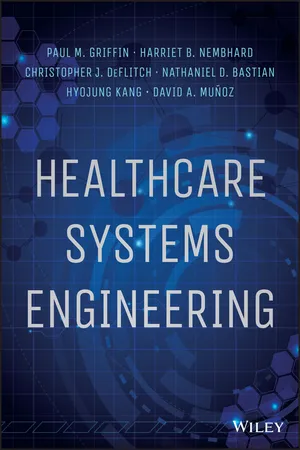
Healthcare Systems Engineering
- English
- ePUB (mobile friendly)
- Available on iOS & Android
Healthcare Systems Engineering
About this book
Apply engineering and design principles to revitalize the healthcare delivery system
Healthcare Systems Engineering is the first engineering book to cover this emerging field, offering comprehensive coverage of the healthcare system, healthcare delivery, and healthcare systems modeling. Written by leading industrial engineering authorities and a medical doctor specializing in healthcare delivery systems, this book provides a well-rounded resource for readers of a variety of backgrounds. Examples, case studies, and thoughtful learning activities are used to thoroughly explain the concepts presented, including healthcare systems, delivery, quantification, and design. You'll learn how to approach the healthcare industry as a complex system, and apply relevant design and engineering principles and processes to advance improvements. Written with an eye toward practicality, this book is designed to maximize your understanding and help you quickly apply toward solutions for a variety of healthcare challenges.
Healthcare systems engineering is a new and complex interdisciplinary field that has emerged to address the myriad challenges facing the healthcare industry in the wake of reform. This book functions as both an introduction and a reference, giving you the knowledge you need to move toward better healthcare delivery.
- Understand the healthcare delivery context
- Use appropriate statistical and quantitative models
- Improve existing systems and design new ones
- Apply systems engineering to a variety of healthcare contexts
Healthcare systems engineering overlaps with industrial engineering, operations research, and management science, uniting the principles and practices of these fields together in pursuit of optimal healthcare operations. Although collaboration is focused on practitioners, professionals in information technology, policy and administration, public health, and law all play crucial roles in revamping health care systems. Healthcare Systems Engineering is a complete and authoritative reference for stakeholders in any field.
Frequently asked questions
- Essential is ideal for learners and professionals who enjoy exploring a wide range of subjects. Access the Essential Library with 800,000+ trusted titles and best-sellers across business, personal growth, and the humanities. Includes unlimited reading time and Standard Read Aloud voice.
- Complete: Perfect for advanced learners and researchers needing full, unrestricted access. Unlock 1.4M+ books across hundreds of subjects, including academic and specialized titles. The Complete Plan also includes advanced features like Premium Read Aloud and Research Assistant.
Please note we cannot support devices running on iOS 13 and Android 7 or earlier. Learn more about using the app.
Information
Chapter 1
The Healthcare Delivery System
“In nothing do men more nearly approach the gods than in giving health to men.”
Overview
1.1 Healthcare Delivery Components
| Type | Delivery Focus | Providers | Conditions/Needs |
| Primary care |
|
|
|
| Urgent care |
|
|
|
| Ambulatory or outpatient care |
|
|
|
| Secondary or acute care |
|
|
|
| Tertiary care |
|
|
|
| Quaternary care |
|
|
|
| Home and community care |
|
|
Table of contents
- Cover
- Title Page
- Copyright
- Table of Contents
- Acknowledgments
- Chapter 1: The Healthcare Delivery System
- Chapter 2: Complexity and Systems in Healthcare
- Chapter 3: Patient Flow
- Chapter 4: Healthcare Financing
- Chapter 5: Health Data and Informatics
- Chapter 6: Lean
- Chapter 7: Six Sigma
- Chapter 8: Reliability and Patient Safety
- Chapter 9: Health Analytics
- Chapter 10: Capacity Management
- Chapter 11: Healthcare Logistics
- Chapter 12: Health Supply Chains
- Chapter 13: Infection Control
- Index
- End User License Agreement